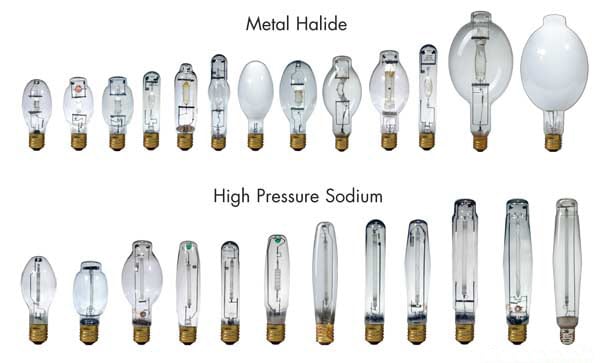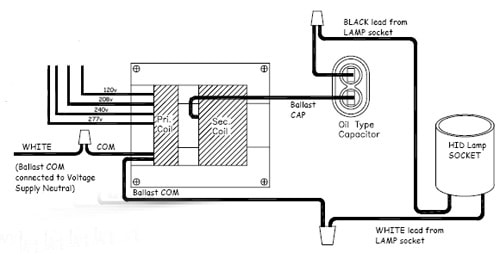These are the traditional metal halide lamps. They’re characterized by their 3 electrodes in the arc tube (1 starting probe electrode, and 2 operating electrodes). To start, a discharge is created across a tiny gap between the starting probe electrode and one of the operating electrodes, electrons leap across the arc tube to the other operating electrode. Thus, the lamp “probe starts,” and a bimetal switch removes the starting probe electrode from the circuit.
The electric arc of HID lamps is much shorter and has a higher photometric brightness than a fluorescent arc. The lamps are also often higher in wattage ratings, and they may require a specific operating position; base-up, base-down, or base-horizontal. Because the precise size of the arc tube and mixture of materials in the tube differ, each type has its own operating and end-of-life characteristics, which often directly relate to maintenance/ troubleshooting concerns. The family of HID sources includes:
Mercury-vapor lamp (MV). With the lowest efficacy of any of the HID sources, most of these lamps in the 100V to 1000W ratings have an average rated life of 24,000 hrs. Because of this relatively long life, coupled with a slow reduction in lumen output, you should replace them well before reaching their average-rated life. Normal end-of-life (EOL) is a nonstart condition or very low light output caused by blackening of the arc tube from electrode deterioration.
Metal-halide lamp (MH). Operating conditions pulse start ballast troubleshooting,
(HID) is a broad term used to describe any lighting system using a gaseous discharge arc lamp in which the gas-filled arc tube
operates at several times normal atmospheric pressure compared to the near vacuum conditions in fluorescent lamps. The various
types of HID lamps are categorized and named by the type of gas contained within the arc tube.
The electrical arc produced between the two main electrodes of an HID lamp is much like a runaway short circuit which can be
sustained indefinitely. Once sufficient voltage is present, the gases within the arc tube are “ionized” to where they will conduct the
arc current. Arc formation is not an immediate process. It can take several seconds for the arc to be established, and several
minutes until full light output can be reached.
HID lamps are negative impedance pulse start ballast troubleshooting. This means that unless controlled, the current would continue to increase, causing
the lamp to fail almost instantly after starting. For this reason, a ballast, which is a current-limiting device, must be used with every
HID lamp. The ballast serves three functions. It provides the proper starting voltage to establish the arc. Second, it supplies the
proper voltage to operate the lamp. Third, the ballast limits the lamp current to a level prescribed by the lamp manufacturer for the
particular type of lamp being used. Ballasts must always be matched to the particular lamp type, wattage, and line voltage being
used. Never use a ballast for any lamp, installation or purpose other than that for which it has been specifically designed.
The ionization voltage of all HID lamps increases greatly when the lamp is hot.
If power to the lamp is interrupted, the lamp must
be allowed to cool for a time, usually several minutes, before the arc can be reestablished and normal operation resumed. For this
reason, some ballasts are available with a tap to operate a standby, or auxiliary, incandescent lamp through an appropriate interface
pulse start ballast troubleshooting.
The 120-volt lead on dual-,tri-, and multi-voltage ballasts can be used as a tap for standby lighting when the ballast is
supplied by a higher line voltage. For some ballast-lamp combinations, an instant restrike starter is available.



